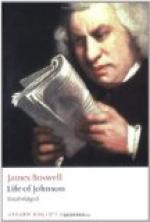Upon hearing that Sir Allan M’Lean was arrived, the inhabitants, who still consider themselves as the people of M’Lean, to whom the island formerly belonged, though the Duke of Argyle has at present possession of it, ran eagerly to him.
We were accommodated this night in a large barn, the island, affording no lodging that we should have liked so well. Some good hay was strewed at one end of it, to form a bed for us, upon which we lay with our clothes on; and we were furnished with blankets from the village[899]. Each of us had a portmanteau for a pillow. When I awaked in the morning, and looked round me, I could not help smiling at the idea of the chief of the M’Leans, the great English Moralist, and myself, lying thus extended in such a situation.
WEDNESDAY, OCTOBER 20.
Early in the morning we surveyed the remains of antiquity at this place, accompanied by an illiterate fellow, as Cicerone, who called himself a descendant of a cousin of Saint Columba, the founder of the religious establishment here. As I knew that many persons had already examined them, and as I saw Dr. Johnson inspecting and measuring several of the ruins of which he has since given so full an account, my mind was quiescent; and I resolved to stroll among them at my ease, to take no trouble to investigate minutely, and only receive the general impression of solemn antiquity, and the particular ideas of such objects as should of themselves strike my attention.
We walked from the monastery of Nuns to the great church or cathedral, as they call it, along an old broken causeway. They told us, that this had been a street; and that there were good houses built on each side. Dr. Johnson doubted if it was any thing more than a paved road for the nuns. The convent of Monks, the great church, Oran’s chapel, and four other chapels, are still to be discerned. But I must own that Icolmkill did not answer my expectations; for they were high, from what I had read of it, and still more from what I had heard and thought of it, from my earliest years. Dr. Johnson said, it came up to his expectations, because he had taken his impression from an account of it subjoined to Sacheverel’s History of the Isle of Man[900], where it is said, there is not much to be seen here. We were both disappointed, when we were shewn what are called the monuments of the kings of Scotland, Ireland, and Denmark, and of a King of France. There are only some grave-stones flat on the earth, and we could see no inscriptions. How far short was this of marble monuments, like those in Westminster Abbey, which I had imagined here! The grave-stones of Sir Allan M’Lean’s family, and of that of M’Quarrie, had as good an appearance as the royal grave-stones; if they were royal, we doubted.
My easiness to give credit to what I heard in the course of our Tour was too great. Dr. Johnson’s peculiar accuracy of investigation detected much traditional fiction, and many gross mistakes. It is not to be wondered at, that he was provoked by people carelessly telling him, with the utmost readiness and confidence, what he found, on questioning them a little more, was erroneous[901]. Of this there were innumerable instances.




